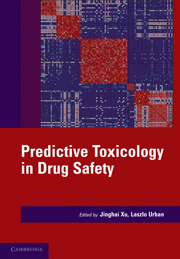Book contents
- Frontmatter
- Contents
- Contributors
- Prologue – Predictive toxicology: a new chapter in drug safety evaluation
- PREDICTIVE TOXICOLOGY IN DRUG SAFETY
- I SPECIFIC AREAS OF PREDICTIVE TOXICOLOGY
- 1 The human predictive value of combined animal toxicity testing: current state and emerging approaches
- 2 Screening approaches for genetic toxicity
- 3 Cardiac safety
- 4 Predicting drug-induced liver injury: safer patients or safer drugs?
- 5 In vitro evaluation of metabolic drug–drug interactions
- 6 Reliability of reactive metabolite and covalent binding assessments in prediction of idiosyncratic drug toxicity
- 7 Immunotoxicity: technologies for predicting immune stimulation, a focus on nucleic acids and haptens
- 8 Predictive models for neurotoxicity assessment
- 9 De-risking developmental toxicity-mediated drug attrition in the pharmaceutical industry
- II INTEGRATED APPROACHES OF PREDICTIVE TOXICOLOGY
- Epilogue
- Index
- Plate section
- References
4 - Predicting drug-induced liver injury: safer patients or safer drugs?
from I - SPECIFIC AREAS OF PREDICTIVE TOXICOLOGY
Published online by Cambridge University Press: 06 December 2010
- Frontmatter
- Contents
- Contributors
- Prologue – Predictive toxicology: a new chapter in drug safety evaluation
- PREDICTIVE TOXICOLOGY IN DRUG SAFETY
- I SPECIFIC AREAS OF PREDICTIVE TOXICOLOGY
- 1 The human predictive value of combined animal toxicity testing: current state and emerging approaches
- 2 Screening approaches for genetic toxicity
- 3 Cardiac safety
- 4 Predicting drug-induced liver injury: safer patients or safer drugs?
- 5 In vitro evaluation of metabolic drug–drug interactions
- 6 Reliability of reactive metabolite and covalent binding assessments in prediction of idiosyncratic drug toxicity
- 7 Immunotoxicity: technologies for predicting immune stimulation, a focus on nucleic acids and haptens
- 8 Predictive models for neurotoxicity assessment
- 9 De-risking developmental toxicity-mediated drug attrition in the pharmaceutical industry
- II INTEGRATED APPROACHES OF PREDICTIVE TOXICOLOGY
- Epilogue
- Index
- Plate section
- References
Summary
INTRODUCTION: THE PROBLEM OF DRUG-INDUCED LIVER INJURY
Liver injury or hepatotoxicity caused by medications has been a major challenge for health care professionals and drug developers alike. In the United States alone, drug-induced liver injury (DILI) is responsible for 5 percent of all hospital admissions and 50 percent of all acute liver failures. DILI is the most common reason for black-box warnings among drugs previously approved for marketing, as well as drug withdrawals after regulatory approval for marketing. DILI is also a leading reason for nonapproval decisions by the Food and Drug Administration (FDA) in the United States, and a major reason why drugs fail in clinical and preclinical development.
Drugs for which development, approval, or clinical usage were significantly impacted due to hepatotoxicity include troglitazone, bromfenac, tienilic acid, temafloxacin, nomifensin, perhexiline, ibufenac, benoxaprofen, zileutin, trovafloxacin, tolcapone, felbamate, iproniazid, ticrynafen, labetalol, alpidem, ebrotidine, dilevalol, tasosartan, telithromycin, and ximelagatran. Several textbooks have been published on the topic of DILI (e.g., References 5, 6). There is also an annual summary of drugs associated with hepatotoxicity, which provides excellent updates on this topic.
Regulators of the pharmaceutical industry have made it a priority to provide clinical and preclinical guidance to improve detection of DILI. Databases of potentially hepatotoxic drugs have been established, interagency collaborations aimed at better prediction of DILI are underway.
- Type
- Chapter
- Information
- Predictive Toxicology in Drug Safety , pp. 54 - 75Publisher: Cambridge University PressPrint publication year: 2010



